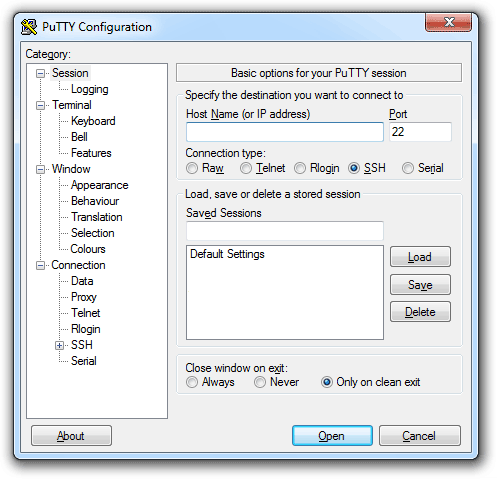
Lastly, you need to upload your public key to the server:

Save your public key to the same location on your computer and name it anything you like.Īnd that is it, you have generated your SSH Key pair.Save your private key to any desired location on your computer and name it anything you like.For additional security it is highly recommended to think of a passphrase for your SSH key (However, you can also leave it empty):.Your public SSH key will be displayed on the screen:.When the progress bar starts loading, move your mouse randomly across the area to load up the bar and generate your key pair.Generate your SSH Key pair by clicking the Generate button.Before generating your SSH Key pair, you can edit some settings, for example, key length, however, in most cases the default options will work just fine.You should be able to see a window like this:.Open up PuTTYgen by double clicking on the puttygen.exe file you have downloaded in Step 1.No installation is required for PuTTYgen, it will run when you execute the file. You should be able to see this file downloaded:.Most of you have PuTTY installed on your computers already, however, to generate SSH Keys you also will need PuTTYgen.

Putty ssh options download#
Putty ssh options how to#
In this tutorial, we will focus on Windows users who use PuTTY for connections to the server and show how to generate PuTTY SSH Keys. Of course, you can upload keys of multiple users so that you or other authorized users would be able to connect to the server from different computers.Īs you can see this is a much safer connection method. When connecting to the server, a validation of these two keys is made and if the key pair passes the validation you are allowed to connect.

The private key is placed on your local machine and the public key is uploaded to the server. Basically, you generate a key pair (private key and public key). SSH Key authentication only allows connections from clients whose key matches the one on the server.
Putty ssh options password#
However, if your password gets leaked, it is a major risk as anyone who knows your password will be able to get into the server. With password authentication, you can connect to your server from any location, you only need to fill in your password. Therefore, it is highly recommended to use SSH Key authentication method for connections to your servers. It is definitely more secure than the usual SSH password authentication. SSH keys are one of the most secure SSH authentication options. To log out use whatever command is used to logout from the server you are logged into (typically “exit”, “logout” or ctrl+d).Download Ultimate SSH Commands Cheat Sheet The screenshot below shows a successful login with the command prompt awaiting a command from the user. The password is not echoed to the screen. It first prompts for your login name (entered here as “chris”) and then for your password. The screenshot below shows PuTTY connecting to the SSH server. To exit PuTTY at this point instead of connecting click the “Cancel” button. The “Open” button is at the bottom of the window. This is illustrated in the screenshot above where a saved configuration has been loaded. To connect to the SSH server with PuTTY click the “Open” button once all the configuration options have been set.

Note also the “Open” button is highlighted this is what you click to actually connect to the SSH server. The is illustrated in the screenshot below. To load a saved PuTTY configuration, select it from the list of saved settings and click the “Load” button.


 0 kommentar(er)
0 kommentar(er)
